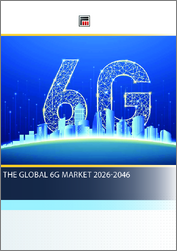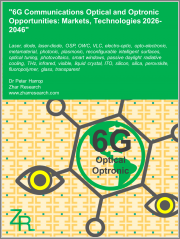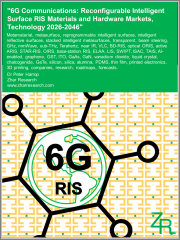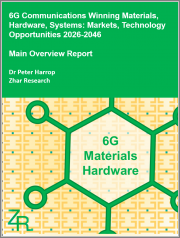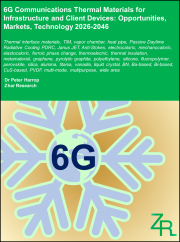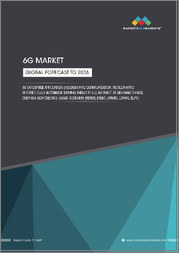
|
시장보고서
상품코드
1838143
세계의 6G 시장 : 기업 용도, 이용 시나리오, 지역별(-2036년)6G Market by Enterprise Application, Usage Scenario and Region - Global Forecast to 2036 |
||||||
세계의 6G 시장 규모는 2030년 114억 달러에서 2036년 1,104억 6,000만 달러로 성장해 2030년부터 2036년까지 CAGR 46.0%가 될 것으로 예측됩니다.
기업에게 6G는 단순한 고속 통신을 넘은 변혁적인 추진력이 되어, 지능화, 효율화, 혁신의 촉진을 실현하는 것이 됩니다. 제조업체는 6G를 활용하여 실시간 디지털 트윈, 로봇 자동화, 예지보전을 실현할 수 있으며, 이들은 초저지연과 방대한 데이터 흐름에 의해 지원됩니다.
| 조사 범위 | |
|---|---|
| 조사 대상 연도 | 2030-2036년 |
| 기준 연도 | 2030년 |
| 예측 기간 | 2030-2036년 |
| 단위 | 금액(달러) |
| 부문별 | 이용 시나리오, 통신 인프라, 최종 사용자, 기업용도, 지역별 |
| 대상 지역 | 북미, 유럽, 아시아태평양, 중동, 아프리카, 라틴아메리카 |
의료 분야에서 6G는 원활하고 고신뢰성의 원격 수술, 홀로그램 진료 및 환자의 지속적인 모니터링을 가능하게 합니다. 금융기관은 빠르고 견고한 네트워크를 활용하여 순간적으로 안전한 거래와 AI를 통한 리스크 모델의 고도화를 실현합니다. 소매업 및 호스피탈리티 산업에서는 AR/VR 및 메타버스 플랫폼을 통해 슈퍼 개인화된 몰입형 고객 경험을 제공할 수 있습니다. 또한 정부 및 공공 부문은 스마트 시티, 재해 관리, 국가 안보 분야에서 6G를 활용하여 운송 및 물류 업계에서는 자율주행 모빌리티 최적화 및 실시간 공급망 추적을 실현합니다. 특필해야할 것은 6G가 AI와 센싱 기술을 통합함으로써 모든 산업에서 새로운 비즈니스 모델의 창출, 의사 결정의 고도화, 환경 부하의 저감과 지속 가능한 운영을 가능하게 하는 점입니다. 6G는 단순한 통신 기술의 진화가 아니라 세계 기업들에게 경쟁력과 디지털 전환을 추진하는 전략적 원동력입니다.

최종 사용자별로 기업 부문이 예측 기간 동안 시장을 선도
기업 분야에서 6G는 게임 체인저가 되어, 단순한 접속성을 넘어, 지능적이고 완전하게 자동화된 오퍼레이션을 실현합니다. 초고대역폭과 테라비트급의 통신 속도를 통해 기업은 몰입형 AR/VR 트레이닝, 공동형 디지털 트윈, R&D 및 운영 실시간 시뮬레이션을 원활하게 수행할 수 있습니다. 또한, 서브밀리초 지연 시간은 로봇 프로세스 자동화, 스마트 팩토리, 정밀의료 수술 등의 미션 크리티컬한 용도를 지원합니다. 물류 및 운송 분야에서는 6G의 통합 센싱 기능을 통해 자율주행 차량의 연계와 예측적 공급망 시각화가 가능합니다. 금융업계에서는 초고속으로 안전한 거래와 AI에 의한 대규모 부정검출을 실현하고, 에너지 및 유틸리티 분야에서는 스마트그리드 최적화, 재생가능에너지 통합, 실시간 감시가 6G의 대규모 IoT 연결에 의해 가능해집니다. 특히 AI 네이티브 디자인을 갖춘 6G는 기업의 의사결정 자동화, 비용 절감, 혁신 가속화를 촉진합니다. 또한 그린 네트워킹 기능을 통해 기업이 지속가능성 목표를 달성할 수 있도록 지원합니다. 총 6G는 연결성, 지능, 지속가능성을 통합한 강력한 생태계로서 기업 경쟁력의 새로운 형태를 재정의하는 태세를 갖추고 있습니다.
기업 용도별로 IoBNT(Internet of Bio-Nano-Things) 부문이 예측 기간 동안 가장 빠른 성장률을 나타낼 것으로 예측됩니다.
6G는 나노스케일 디바이스와 생체센서가 서로 통신하고 의료, 환경 모니터링, 생명공학에 획기적인 획기적인 획기적인 획기적인 협업을 가능하게 하기 때문에 IoBNT(Internet of Bio-Nano-Things)의 실현에 필수적인 존재입니다. 6G 초저지연과 테라비트급 통신 속도는 인체와 환경에 내장된 수백만 개의 나노센서로부터의 데이터 전송을 원활하게 실현합니다. 또한, 서브 테라헤르츠 및 테라헤르츠 대역의 주파수는 소형 안테나 및 단거리 통신이 필요한 나노 디바이스를 지원합니다. AI 네이티브 지능을 갖춘 6G 네트워크는 생체 및 화학 데이터를 실시간으로 해석 및 응답하여 맞춤형 의료, 조기 질환 검출, 표적형 약물전달, 신경 인터페이스 시스템 등의 응용을 실현합니다. 의료 이외에도 6G가 지원하는 IoBNT는 오염물질, 식품안전, 농업환경 등을 분자 수준에서 감시할 수 있습니다. 6G의 중요성은 이러한 대규모 IoBNT 에코시스템을 안전하고 효과적으로 성립하기 위한 대역폭, 신뢰성, 지적 제어 기능을 제공한다는 점에 있습니다.
본 보고서에서는 세계 6G 시장을 조사했으며, 시장 개요, 시장 성장 영향요인 분석, 기술 및 특허 동향, 법규제 환경, 사례연구, 시장 규모 추이와 예측, 각종 구분 및 지역/주요 국가별 상세 분석, 경쟁 구도, 주요기업 프로파일 등을 정리했습니다.
자주 묻는 질문
목차
제1장 서론
제2장 조사 방법
제3장 주요 요약
제4장 중요 인사이트
제5장 시장 개요
- 시장 역학
- 성장 촉진요인
- 억제요인
- 기회
- 과제
- 6G 시장의 간단한 역사
- 공급망 분석
- 생태계 분석
- 규제 상황
- 특허 분석
- Porter's Five Forces 분석
- 주요 이해관계자와 구매 기준
- 기술 분석
- 고객사업에 영향을 주는 동향/혼란
- 2025-2026년 주요 회의 및 이벤트
- 기술 로드맵
- 현재의 비즈니스 모델과 신흥 비즈니스 모델
- 6G 시장 : 모범 사례
- 6G 시장 : 툴, 기술, 프레임워크
- 투자 및 자금조달 시나리오
- AI와 생성형 AI 소개
- 6G의 6개 기둥
- 6G 스펙트럼 상황
- 6G 네트워크의 특징
제6장 6G 시장 : 이용 시나리오별
- 더욱 강화된 모바일 광대역
- 초고신뢰성 저지연 통신
- 장거리 및 고이동성 통신
- 초대규모 머신 유형 통신
- 초저소비 전력통신
제7장 6G 시장 : 통신 인프라별
- 셀룰러
- 광대역
- 고정
제8장 6G 시장 : 최종 사용자별
- 소비자
- 기업
- 제조
- 헬스케어 및 생명과학
- 미디어 및 엔터테인먼트
- 자동차
- 항공우주 및 방위
- 기타
제9장 6G 시장 : 기업용도별
- 홀로그램 통신
- 촉각 인터넷
- 완전자동운전
- 인더스트리 5.0
- IoBNT(Bio-Nano-Things)
- 기타
제10장 6G 시장 : 지역별
- 북미
- 북미 : 거시경제 전망
- 미국
- 캐나다
- 유럽
- 유럽 : 거시경제 전망
- 영국
- 독일
- 프랑스
- 이탈리아
- 기타
- 아시아태평양
- 아시아태평양 : 거시경제 전망
- 중국
- 인도
- 일본
- 기타
- 중동 및 아프리카
- 중동 및 아프리카 : 거시경제 전망
- 아랍에미리트(UAE)
- 사우디아라비아
- 남아프리카
- 기타
- 라틴아메리카
- 라틴아메리카 : 거시경제 전망
- 브라질
- 멕시코
- 기타
제11장 경쟁 구도
- 4G, 5G, 6G의 기술 비교
- 경쟁 시나리오
- 주요 6G 서비스 제공업체의 기업 평가 및 재무 지표
제12장 기업 프로파일
- 주요 기업
- AT&T
- NTT DOCOMO
- RELIANCE JIO
- BHARTI AIRTEL
- VODAFONE
- SK TELECOM
- VERIZON
- DEUTSCHE TELEKOM
- TELEFONICA SA
- CHINA MOBILE
- CHINA UNICOM
- ORANGE SA
- RAKUTEN GROUP
- KT CORPORATION
- SINGTEL
- KDDI CORPORATION
- E&
제13장 인접 시장과 관련 시장
제14장 부록
JHS 25.10.22The 6G market is projected to grow from USD 11.40 billion in 2030 to USD 110.46 billion by 2036, at a CAGR of 46.0%, from 2030 to 2036. For organizations, 6G will be a transformational enabler, going far beyond faster connectivity to drive intelligence, efficiency, and innovation. Enterprises in manufacturing will leverage 6G for real-time digital twins, robotic automation, and predictive maintenance, all supported by ultra-low latency and massive data flows.
| Scope of the Report | |
|---|---|
| Years Considered for the Study | 2030-2036 |
| Base Year | 2030 |
| Forecast Period | 2030-2036 |
| Units Considered | Value (USD Million/ Billion) |
| Segments | By usage scenario, communication infrastructure, end user, enterprise application, and region |
| Regions covered | North America, Europe, Asia Pacific, Middle East & Africa, and Latin America |
In healthcare, 6G will enable seamless and highly reliable remote surgery, holographic consultations, and continuous patient monitoring. Financial institutions will benefit from instant, secure transactions and AI-powered risk modeling enabled by high-speed, resilient networks. Retail and hospitality organizations can deliver hyper-personalized, immersive customer experiences through AR/VR and metaverse platforms. Governments and public sector bodies will use 6G for smart cities, disaster management, and national security, while transport and logistics players can optimize autonomous mobility and real-time supply chain tracking. Importantly, 6G's integration of AI and sensing will allow organizations across sectors to unlock new business models, enhance decision-making, and build greener, more sustainable operations. In essence, 6G is not just a telecom upgrade but a strategic driver of competitiveness and digital transformation for organizations worldwide.

By end user, the enterprises segment will lead the market during the forecast period
In the enterprises segment, 6G will be a game-changer, enabling organizations to move beyond connectivity toward intelligent, fully automated operations. With ultra-high bandwidth and terabit-level speeds, enterprises can seamlessly run immersive AR/VR training, collaborative digital twins, and real-time simulations for R&D or operations. Its sub-millisecond latency will support mission-critical applications such as robotic process automation, smart factories, and precision healthcare procedures. Enterprises in logistics and transportation will benefit from autonomous vehicle coordination and predictive supply chain visibility powered by 6G's integrated sensing. The financial sector will use it to enhance ultra-fast, secure transactions and AI-driven fraud detection at scale. Meanwhile, energy and utilities can optimize smart grids, renewable integration, and real-time monitoring through massive IoT connectivity. Importantly, 6G's AI-native design will empower enterprises to automate decision-making, reduce overheads, and accelerate innovation. Beyond efficiency, its green networking capabilities will help enterprises meet sustainability goals. Overall, 6G is poised to redefine enterprise competitiveness by integrating connectivity, intelligence, and sustainability into a single, powerful ecosystem.
By enterprise application, the Internet of Bio-Nano Things segment is expected to register the fastest growth rate during the forecast period
6G will be critical for the Internet of Bio-Nano-Things (IoBNT), where nanoscale devices and biological sensors communicate to enable breakthroughs in healthcare, environmental monitoring, and biotechnology. The ultra-low latency and terabit-level speeds of 6G ensure seamless data transmission from millions of nanosensors embedded in the human body or environment. Its sub-THz and terahertz spectrum supports the tiny antennas and short-range communications needed for nanoscale devices. With AI-native intelligence, 6G networks can analyze and act on biological and chemical data in real time, enabling applications such as personalized medicine, early disease detection, targeted drug delivery, and neural interface systems. Beyond healthcare, IoBNT powered by 6G could monitor pollutants, food safety, and agricultural conditions at a molecular level. The importance of 6G lies in providing the bandwidth, reliability, and intelligent orchestration that make large-scale IoBNT ecosystems feasible, safe, and effective.
North America is expected to hold the second-largest market size during the forecast period
The 6G market in North America is experiencing rapid growth, driven by significant investments from regional governments and increased international collaboration. In August 2024, the US and Sweden signed a new bilateral agreement to pool resources, expertise, and technology leadership in new, developing, and future connectivity technologies. These will cover the cooperation areas of 6G Research, including Possible Funding, 6G spectrum allocation to include the introduction of new technologies in existing frequency bands, global harmonization of 6G frequency bands, development of international standards-aligned technologies, promotion of a wide and open 6G ecosystem, and 6G technologies that can be used for bridging digital divides. In the US, the foundation for 6G innovation has been established since 2021, as the administration has invested USD 2.5 billion to further research and development in 6G. Key institutions like Stanford, MIT, and Purdue are pushing the frontiers through novel thrusts in areas like terahertz communications, AI-driven network management, and advanced antenna technologies.
Breakdown of Primary Interviews
The study offers insights from a range of industry experts, including solution vendors and Tier 1 companies. The breakdown of the primary interviews is as follows:
- By Company Type: Tier 1 - 20%, Tier 2 - 10%, and Tier 3 - 70%
- By Designation: C-level - 9%, Directors - 18%, and Others - 73%
- By Region: North America - 55%, Europe - 9%, Asia Pacific - 36%
The major players in the 6G market are AT&T (US), NTT DOCOMO (Japan), Orange S.A. (France), Reliance Jio (India), Bharti Airtel (India) Vodafone Group (UK), SK Telecom (South Korea), Deutsche Telekom (Germany), Verizon (US), China Mobile (China), Telefonica (Spain), China Unicom (China), and Rakuten Mobile (Japan) KT Corporation (South Korea), Singtel (Singapore), KDDI Corporation (Japan), e& (UAE). These players have adopted various growth strategies, such as partnerships, agreements, collaborations, product launches, product enhancements, and acquisitions, to expand their footprint in the 6G market.
Research Coverage
The market study covers the 6G market size across different segments. It aims at estimating the market size and the growth potential across various segments, including Usage Scenario (Further-enhanced Mobile Broadband (FEMBB), Extremely Reliable and Low-latency Communications (ERLLC), Long-distance and High-mobility Communications (LDHMC), Ultra-massive Machine Type Communications (UMMTC), Extremely Low-power Communications (ELPC)), Enterprise Application (Holographic Communications, Tactile/Haptic Internet, Fully Automated Driving, Industry 5.0, Internet of Bio-Nano Things, Other Enterprise Applications (Deep-sea Sightseeing and Space Travel)), Communication Infrastructure (Cellular, Broadband, Fixed), End User (Consumers and Enterprises (Manufacturing, Healthcare & Life Sciences, Automotive, Media & Entertainment, Aerospace & Defense, Other Enterprises [Retail & E-commerce, Energy & Utilities, Education])), and Region (North America, Europe, Asia Pacific, Middle East & Africa, and Latin America). The study includes an in-depth competitive analysis of the leading market players, their company profiles, key observations related to product and business offerings, recent developments, and market strategies.
Key Benefits of Buying the Report
The report will help market leaders and new entrants with information on the closest approximations of the global 6G market's revenue numbers and subsegments. It will also help stakeholders understand the competitive landscape and gain more insights to position their businesses better and plan suitable go-to-market strategies. Moreover, the report will provide insights for stakeholders to understand the market's pulse and provide them with information on key market drivers, restraints, challenges, and opportunities.
The report provides insights into the following points:
- Analysis of key drivers (Technological advancements, deliver extreme performance and highly advanced use cases, growing metaverse traction), restraints (High initial cost, limited spectrum availability, regulatory and standardization challenges, terahertz (THz) frequency challenges and energy efficiency concerns), opportunities (Transformative applications, global connectivity, detailed sensing and high-precision positioning technologies offered by 6G networks), and challenges (Security and privacy, ethical and social implications, environmental concerns) influencing the growth of the 6G market.
- Product Development/Innovation: Detailed insights on upcoming technologies, research & development activities, and new product & service launches in the 6G market.
- Market Development: The report provides comprehensive information about lucrative markets and analyzes the 6G market across various regions.
- Market Diversification: Exhaustive information about new products & services, untapped geographies, recent developments, and investments in the 6G market.
- Competitive Assessment: In-depth assessment of market shares, growth strategies, and service offerings of leading players such as AT&T (US), NTT DoCoMo (Japan), Orange S.A. (France), Reliance Jio (India), Bharti Airtel (India) Vodafone Group (UK), SK Telecom (South Korea), Deutsche Telekom (Germany), Verizon (US), China Mobile (China), Telefonica (Spain), China Unicom (China), Rakuten Mobile (Japan) KT Corporation (South Korea), Singtel (Singapore), KDDI Corporation (Japan), and e& (UAE).
TABLE OF CONTENTS
1 INTRODUCTION
- 1.1 STUDY OBJECTIVES
- 1.2 MARKET DEFINITION
- 1.3 STUDY SCOPE
- 1.3.1 MARKET SEGMENTATION AND REGIONS COVERED
- 1.3.2 INCLUSIONS AND EXCLUSIONS
- 1.4 YEARS CONSIDERED
- 1.5 CURRENCY CONSIDERED
- 1.6 STAKEHOLDERS
- 1.7 SUMMARY OF CHANGES
2 RESEARCH METHODOLOGY
- 2.1 RESEARCH DATA
- 2.1.1 SECONDARY DATA
- 2.1.2 PRIMARY DATA
- 2.1.2.1 Primary interviews with experts
- 2.1.2.2 Breakdown of primary profiles
- 2.1.2.3 Key insights from industry experts
- 2.2 MARKET SIZE ESTIMATION
- 2.2.1 TOP-DOWN APPROACH
- 2.2.2 BOTTOM-UP APPROACH
- 2.2.3 6G MARKET ESTIMATION: DEMAND-SIDE ANALYSIS
- 2.3 DATA TRIANGULATION
- 2.4 RESEARCH ASSUMPTIONS
- 2.5 RISK ASSESSMENT
- 2.6 RESEARCH LIMITATIONS
3 EXECUTIVE SUMMARY
4 PREMIUM INSIGHTS
- 4.1 ATTRACTIVE OPPORTUNITIES FOR PLAYERS IN 6G MARKET
- 4.2 6G MARKET, BY USAGE SCENARIO
- 4.3 6G MARKET, BY ENTERPRISE APPLICATION
- 4.4 6G MARKET, BY END USER
- 4.5 6G MARKET, BY ENTERPRISE
- 4.6 6G MARKET, BY COMMUNICATION INFRASTRUCTURE
- 4.7 NORTH AMERICAN 6G MARKET, BY END USER AND ENTERPRISE APPLICATION
5 MARKET OVERVIEW
- 5.1 MARKET DYNAMICS
- 5.1.1 DRIVERS
- 5.1.1.1 Technological advancements
- 5.1.1.2 Deliverance of extreme performance and highly advanced use cases
- 5.1.1.3 Growing metaverse traction
- 5.1.2 RESTRAINTS
- 5.1.2.1 High initial cost
- 5.1.2.2 Limited spectrum availability
- 5.1.2.3 Regulatory and standardization challenges
- 5.1.2.4 Terahertz (THz) frequency challenges and energy efficiency concerns
- 5.1.3 OPPORTUNITIES
- 5.1.3.1 Transformative applications
- 5.1.3.2 Global connectivity
- 5.1.3.3 Emergence of detailed sensing and high-precision positioning technologies
- 5.1.4 CHALLENGES
- 5.1.4.1 Security and privacy
- 5.1.4.2 Ethical and social implications
- 5.1.4.3 Environmental concerns
- 5.1.1 DRIVERS
- 5.2 BRIEF HISTORY OF 6G MARKET
- 5.2.1 2017-2019: EARLY CONCEPTS AND VISION
- 5.2.2 2019-2021: INITIATION OF RESEARCH
- 5.2.3 2021-2023: GLOBAL COLLABORATION AND STANDARDIZATION EFFORTS
- 5.2.4 2024-PRESENT: EARLY TESTING AND PROTOTYPING
- 5.3 SUPPLY CHAIN ANALYSIS
- 5.4 ECOSYSTEM ANALYSIS
- 5.5 REGULATORY LANDSCAPE
- 5.5.1 REGULATORY BODIES, GOVERNMENT AGENCIES, AND OTHER ORGANIZATIONS
- 5.5.2 KEY REGULATIONS
- 5.5.2.1 North America
- 5.5.2.1.1 US
- 5.5.2.1.2 Canada
- 5.5.2.2 Europe
- 5.5.2.2.1 UK
- 5.5.2.2.2 Germany
- 5.5.2.2.3 Italy
- 5.5.2.2.4 France
- 5.5.2.3 Asia Pacific
- 5.5.2.3.1 China
- 5.5.2.3.2 India
- 5.5.2.3.3 Australia
- 5.5.2.3.4 Japan
- 5.5.2.4 Middle East & Africa
- 5.5.2.4.1 Saudi Arabia
- 5.5.2.4.2 South Africa
- 5.5.2.5 Latin America
- 5.5.2.5.1 Brazil
- 5.5.2.5.2 Mexico
- 5.5.2.1 North America
- 5.6 PATENT ANALYSIS
- 5.6.1 METHODOLOGY
- 5.7 PORTER'S FIVE FORCES ANALYSIS
- 5.7.1 THREAT OF NEW ENTRANTS
- 5.7.2 THREAT OF SUBSTITUTES
- 5.7.3 BARGAINING POWER OF SUPPLIERS
- 5.7.4 BARGAINING POWER OF BUYERS
- 5.7.5 INTENSITY OF COMPETITIVE RIVALRY
- 5.8 KEY STAKEHOLDERS AND BUYING CRITERIA
- 5.8.1 KEY STAKEHOLDERS IN BUYING PROCESS
- 5.8.2 BUYING CRITERIA
- 5.9 TECHNOLOGY ANALYSIS
- 5.9.1 KEY TECHNOLOGIES
- 5.9.1.1 Massive MIMO
- 5.9.1.2 Terahertz (THz) communication
- 5.9.1.3 Integrated Sensing and Communication (ISAC)
- 5.9.2 ADJACENT TECHNOLOGIES
- 5.9.2.1 Digital twins
- 5.9.2.2 Human-machine interface
- 5.9.2.3 Internet of Things (IoT)
- 5.9.3 COMPLEMENTARY TECHNOLOGIES
- 5.9.3.1 Network slicing
- 5.9.3.2 Optical wireless communications
- 5.9.1 KEY TECHNOLOGIES
- 5.10 TRENDS/DISRUPTIONS IMPACTING CUSTOMER BUSINESS
- 5.11 KEY CONFERENCES AND EVENTS, 2025-2026
- 5.12 TECHNOLOGY ROADMAP
- 5.12.1 SHORT-TERM ROADMAP (2028-2030)
- 5.12.2 MID-TERM ROADMAP (2031-2033)
- 5.12.3 LONG-TERM ROADMAP (2034-2035)
- 5.13 CURRENT AND EMERGING BUSINESS MODELS
- 5.13.1 CONNECTIVITY-AS-A-SERVICE (CAAS)
- 5.13.2 AI-POWERED SERVICE MONETIZATION
- 5.13.3 NETWORK SLICING MONETIZATION
- 5.13.4 SENSING-AS-A-SERVICE (SAAS)
- 5.13.5 NON-TERRESTRIAL NETWORK (NTN) BUNDLES
- 5.13.6 CYBERSECURITY-AS-A-SERVICE
- 5.13.7 SUBSCRIPTION-BASED HOLOGRAPHIC AND HIGH-DEFINITION CONTENT DELIVERY
- 5.14 6G MARKET: BEST PRACTICES
- 5.14.1 CUSTOMER-CENTRIC SERVICE DESIGN
- 5.14.2 FOCUS ON SUSTAINABILITY
- 5.14.3 AI-DRIVEN NETWORK MANAGEMENT
- 5.14.4 SPECTRUM EFFICIENCY AND UTILIZATION
- 5.14.5 SECURITY-FIRST APPROACH
- 5.14.6 USER-CENTRIC INNOVATIONS
- 5.14.7 GLOBAL STANDARDIZATION ALIGNMENT
- 5.15 6G MARKET: TOOLS, TECHNIQUES, AND FRAMEWORKS
- 5.16 INVESTMENT AND FUNDING SCENARIO
- 5.17 INTRODUCTION TO ARTIFICIAL INTELLIGENCE AND GENERATIVE AI
- 5.17.1 IMPACT OF GENERATIVE AI ON 6G
- 5.17.2 USE CASES OF GENERATIVE AI IN 6G MARKET
- 5.17.3 FUTURE OF GENERATIVE AI IN 6G MARKET
- 5.18 SIX PILLARS OF 6G
- 5.18.1 NATIVE AI
- 5.18.2 NETWORKED SENSING
- 5.18.3 EXTREME CONNECTIVITY
- 5.18.4 INTEGRATED NTN
- 5.18.5 TRUSTWORTHINESS
- 5.18.6 SUSTAINABILITY
- 5.19 6G SPECTRUM LANDSCAPE
- 5.19.1 SUB-6 GHZ (BELOW 6 GHZ)
- 5.19.2 MID-BAND (6 GHZ-24 GHZ)
- 5.19.3 MILLIMETER WAVE BAND (24 GHZ-100 GHZ)
- 5.19.4 SUB-THZ (100 GHZ-300 GHZ)
- 5.20 6G NETWORK CHARACTERISTICS
- 5.20.1 INTELLIGENTIZATION
- 5.20.2 CLOUDIZATION
- 5.20.3 SOFTWARIZATION
- 5.20.4 VIRTUALIZATION
- 5.20.5 SLICING
6 6G MARKET, BY USAGE SCENARIO
- 6.1 INTRODUCTION
- 6.1.1 USAGE SCENARIO: 6G MARKET DRIVERS
- 6.2 FURTHER-ENHANCED MOBILE BROADBAND
- 6.2.1 NEED FOR HIGH-SPEED CONNECTIVITY IN DENSELY POPULATED URBAN AREAS TO FUEL MARKET
- 6.3 EXTREMELY RELIABLE LOW-LATENCY COMMUNICATIONS
- 6.3.1 NEED FOR UNPARALLELED RELIABILITY AND MINIMAL LATENCY IN APPLICATIONS DEMANDING INSTANTANEOUS RESPONSE TIMES TO DRIVE MARKET
- 6.4 LONG-DISTANCE AND HIGH-MOBILITY COMMUNICATIONS
- 6.4.1 NEED FOR SEAMLESS COMMUNICATION IN DYNAMIC ENVIRONMENTS TO BOLSTER MARKET
- 6.5 ULTRA-MASSIVE MACHINE TYPE COMMUNICATIONS
- 6.5.1 NEED FOR LOW-LATENCY CONNECTIONS TO SUPPORT VAST NETWORKS OF SENSORS TO BOOST MARKET
- 6.6 EXTREMELY LOW-POWER COMMUNICATIONS
- 6.6.1 ABILITY OF 6G TO ENABLE ADAPTIVE POWER FOR ENERGY OPTIMIZATION IN DEVICES TO DRIVE MARKET
7 6G MARKET, BY COMMUNICATION INFRASTRUCTURE
- 7.1 INTRODUCTION
- 7.1.1 COMMUNICATION INFRASTRUCTURE: 6G MARKET DRIVERS
- 7.2 CELLULAR
- 7.2.1 INCREASING DEMAND FOR HIGH-SPEED MOBILE NETWORKS TO ACCELERATE MARKET GROWTH
- 7.3 BROADBAND
- 7.3.1 EXPANSION OF HIGH INTERNET CONNECTIVITY IN RURAL AND REMOTE AREAS TO FUEL MARKET
- 7.4 FIXED
- 7.4.1 INCREASING DEMAND FOR HIGH-SPEED AND RELIABLE CONNECTIVITY IN STATIONARY ENVIRONMENTS TO BOLSTER MARKET
8 6G MARKET, BY END USER
- 8.1 INTRODUCTION
- 8.1.1 END USER: 6G MARKET DRIVERS
- 8.2 CONSUMERS
- 8.2.1 EXPANSION OF DIGITAL CONTENT TO BOOST SATELLITE SERVICE GROWTH
- 8.3 ENTERPRISES
- 8.3.1 MANUFACTURING
- 8.3.1.1 Need for real-time threat detection and mitigation to drive market
- 8.3.1.2 Use cases
- 8.3.1.2.1 Quality control
- 8.3.1.2.2 Remote operation & control
- 8.3.2 HEALTHCARE & LIFE SCIENCES
- 8.3.2.1 Remote patient monitoring and AI-driven diagnostics to drive market
- 8.3.2.2 Use cases
- 8.3.2.2.1 AI-driven diagnostics
- 8.3.2.2.2 Drug development & research
- 8.3.2.2.3 Virtual reality (VR) therapy
- 8.3.3 MEDIA & ENTERTAINMENT
- 8.3.3.1 Demand for high-definition and live-streaming content to accelerate market growth
- 8.3.3.2 Use cases
- 8.3.3.2.1 Ultra-high-definition streaming
- 8.3.3.2.2 Real-time content creation and collaboration
- 8.3.3.2.3 Content distribution & delivery
- 8.3.4 AUTOMOTIVE
- 8.3.4.1 Need to enhance processes, products, and overall operational efficiency to drive market
- 8.3.4.2 Use cases
- 8.3.4.2.1 Remote vehicle control
- 8.3.4.2.2 Augmented reality navigation
- 8.3.5 AEROSPACE & DEFENSE
- 8.3.5.1 6G-based secure and reliable communication channels to drive market growth
- 8.3.5.2 Use cases
- 8.3.5.2.1 Enhanced drone operations
- 8.3.5.2.2 Augmented reality for pilot training
- 8.3.5.2.3 Enhanced electronic warfare capabilities
- 8.3.6 OTHER ENTERPRISES
- 8.3.6.1 Use cases
- 8.3.6.1.1 Energy efficiency optimization
- 8.3.6.1.2 Virtual laboratories and simulations
- 8.3.6.1.3 Automated checkout systems
- 8.3.6.1 Use cases
- 8.3.1 MANUFACTURING
9 6G MARKET, BY ENTERPRISE APPLICATION
- 9.1 INTRODUCTION
- 9.1.1 ENTERPRISE APPLICATION: 6G MARKET DRIVERS
- 9.2 HOLOGRAPHIC COMMUNICATIONS
- 9.2.1 NEED FOR VIRTUAL MEETINGS TO DRIVE MARKET
- 9.3 TACTILE/HAPTIC INTERNET
- 9.3.1 NEED TO ENGAGE WITH DIGITAL ENVIRONMENTS THROUGH TOUCH AND PROPRIOCEPTION TO DRIVE MARKET
- 9.4 FULL AUTOMATED DRIVING
- 9.4.1 NEED FOR HIGH DATA RATES FOR SENSOR AND CAMERA TRANSMISSIONS IN AUTOMATED DRIVING SYSTEMS TO PROPEL MARKET
- 9.5 INDUSTRY 5.0
- 9.5.1 DECENTRALIZED MANUFACTURING SYSTEMS AND AUTOMATED MANUFACTURING PROCESSES TO FUEL MARKET
- 9.6 INTERNET OF BIO-NANO THINGS
- 9.6.1 NEED FOR REAL-TIME HEALTH DATA FROM BIO-NANO SENSORS TO ACCELERATE MARKET GROWTH
- 9.7 OTHER ENTERPRISE APPLICATIONS
10 6G MARKET, BY REGION
- 10.1 INTRODUCTION
- 10.2 NORTH AMERICA
- 10.2.1 NORTH AMERICA: MACROECONOMIC OUTLOOK
- 10.2.2 US
- 10.2.2.1 Strategic focus on advancing next-generation wireless communications to drive market
- 10.2.3 CANADA
- 10.2.3.1 Government initiatives for collaboration and investments in next-generation technologies to propel market
- 10.3 EUROPE
- 10.3.1 EUROPE: MACROECONOMIC OUTLOOK
- 10.3.2 UK
- 10.3.2.1 Funding from research institutions and government organizations to fuel market
- 10.3.3 GERMANY
- 10.3.3.1 Government initiatives to expand low-cost connectivity to drive market
- 10.3.4 FRANCE
- 10.3.4.1 Investments in 6G through France 2030 initiative to drive market
- 10.3.5 ITALY
- 10.3.5.1 Enterprise demand and EU-backed R&D to drive 6G adoption
- 10.3.6 REST OF EUROPE
- 10.4 ASIA PACIFIC
- 10.4.1 ASIA PACIFIC: MACROECONOMIC OUTLOOK
- 10.4.2 CHINA
- 10.4.2.1 Focus on innovative technological developments to drive market
- 10.4.3 INDIA
- 10.4.3.1 Increasing focus on eliminating digital or rural-urban divide to drive market
- 10.4.4 JAPAN
- 10.4.4.1 Increased participation of private players and global collaboration with major players to fuel market
- 10.4.5 REST OF ASIA PACIFIC
- 10.5 MIDDLE EAST & AFRICA
- 10.5.1 MIDDLE EAST & AFRICA: MACROECONOMIC OUTLOOK
- 10.5.2 UAE
- 10.5.2.1 Technological advancements, presence of major players, and focus on digitalization to bolster market
- 10.5.3 KSA
- 10.5.3.1 Vision 2030 to drive rapid development of 6G
- 10.5.4 SOUTH AFRICA
- 10.5.4.1 Push for advanced connectivity to support digital transformation and bridge urban-rural digital divide to drive market
- 10.5.5 REST OF MIDDLE EAST & AFRICA
- 10.6 LATIN AMERICA
- 10.6.1 LATIN AMERICA: MACROECONOMIC OUTLOOK
- 10.6.2 BRAZIL
- 10.6.2.1 6G research and government funding to drive market
- 10.6.3 MEXICO
- 10.6.3.1 Investments from major telecom companies and government initiatives to propel market
- 10.6.4 REST OF LATIN AMERICA
11 COMPETITIVE LANDSCAPE
- 11.1 INTRODUCTION
- 11.2 TECHNOLOGY COMPARISON OF 4G, 5G, AND 6G
- 11.3 COMPETITIVE SCENARIO
- 11.3.1 PRODUCT LAUNCHES AND ENHANCEMENTS
- 11.3.2 DEALS
- 11.3.3 OTHER DEVELOPMENTS
- 11.4 COMPANY VALUATION AND FINANCIAL METRICS OF KEY 6G SERVICE PROVIDERS
12 COMPANY PROFILES
- 12.1 KEY PLAYERS
- 12.1.1 AT&T
- 12.1.1.1 Business overview
- 12.1.1.2 Products/Solutions/Services offered
- 12.1.1.3 Recent developments
- 12.1.1.3.1 Deals
- 12.1.1.3.2 Other developments
- 12.1.1.4 MnM view
- 12.1.1.4.1 Right to win
- 12.1.1.4.2 Strategic choices
- 12.1.1.4.3 Weaknesses and competitive threats
- 12.1.2 NTT DOCOMO
- 12.1.2.1 Business overview
- 12.1.2.2 Products/Solutions/Services offered
- 12.1.2.3 Recent developments
- 12.1.2.3.1 Product launches and enhancements
- 12.1.2.3.2 Deals
- 12.1.2.4 MnM view
- 12.1.2.4.1 Right to win
- 12.1.2.4.2 Strategic choices
- 12.1.2.4.3 Weaknesses and competitive threats
- 12.1.3 RELIANCE JIO
- 12.1.3.1 Business overview
- 12.1.3.2 Products/Solutions/Services offered
- 12.1.3.3 Recent developments
- 12.1.3.3.1 Product launches and enhancements
- 12.1.3.3.2 Deals
- 12.1.3.4 MnM view
- 12.1.3.4.1 Right to win
- 12.1.3.4.2 Strategic choices
- 12.1.3.4.3 Weaknesses and competitive threats
- 12.1.4 BHARTI AIRTEL
- 12.1.4.1 Business overview
- 12.1.4.2 Products/Solutions/Services offered
- 12.1.4.3 Recent developments
- 12.1.4.3.1 Deals
- 12.1.4.4 MnM view
- 12.1.4.4.1 Right to win
- 12.1.4.4.2 Strategic choices
- 12.1.4.4.3 Weaknesses and competitive threats
- 12.1.5 VODAFONE
- 12.1.5.1 Business overview
- 12.1.5.2 Products/Solutions/Services offered
- 12.1.5.3 Recent developments
- 12.1.5.3.1 Deals
- 12.1.5.4 MnM view
- 12.1.5.4.1 Right to win
- 12.1.5.4.2 Strategic choices
- 12.1.5.4.3 Weaknesses and competitive threats
- 12.1.6 SK TELECOM
- 12.1.6.1 Business overview
- 12.1.6.2 Products/Solutions/Services offered
- 12.1.6.3 Recent developments
- 12.1.6.3.1 Deals
- 12.1.6.4 MnM view
- 12.1.6.4.1 Right to win
- 12.1.6.4.2 Strategic choices
- 12.1.6.4.3 Weaknesses and competitive threats
- 12.1.7 VERIZON
- 12.1.7.1 Business overview
- 12.1.7.2 Products/Solutions/Services offered
- 12.1.7.3 Recent developments
- 12.1.7.3.1 Product launches and enhancements
- 12.1.7.4 MnM view
- 12.1.7.4.1 Right to win
- 12.1.7.4.2 Strategic choices
- 12.1.7.4.3 Weaknesses and competitive threats
- 12.1.8 DEUTSCHE TELEKOM
- 12.1.8.1 Business overview
- 12.1.8.2 Products/Solutions/Services offered
- 12.1.8.3 MnM view
- 12.1.8.3.1 Right to win
- 12.1.8.3.2 Strategic choices
- 12.1.8.3.3 Weaknesses and competitive threats
- 12.1.9 TELEFONICA S.A.
- 12.1.9.1 Business overview
- 12.1.9.2 Products/Solutions/Services offered
- 12.1.9.3 Recent developments
- 12.1.9.3.1 Deals
- 12.1.9.4 MnM view
- 12.1.9.4.1 Right to win
- 12.1.9.4.2 Strategic choices
- 12.1.9.4.3 Weaknesses and competitive threats
- 12.1.10 CHINA MOBILE
- 12.1.10.1 Business overview
- 12.1.10.2 Products/Solutions/Services offered
- 12.1.10.3 Recent developments
- 12.1.10.3.1 Deals
- 12.1.10.4 MnM view
- 12.1.10.4.1 Right to win
- 12.1.10.4.2 Strategic choices
- 12.1.10.4.3 Weaknesses and competitive threats
- 12.1.11 CHINA UNICOM
- 12.1.11.1 Business overview
- 12.1.11.2 Products/Solutions/Services offered
- 12.1.11.3 MnM view
- 12.1.11.3.1 Right to win
- 12.1.11.3.2 Strategic choices
- 12.1.11.3.3 Weaknesses and competitive threats
- 12.1.12 ORANGE S.A.
- 12.1.12.1 Business overview
- 12.1.12.2 Products/Solutions/Services offered
- 12.1.12.3 MnM view
- 12.1.12.3.1 Right to win
- 12.1.12.3.2 Strategic choices
- 12.1.12.3.3 Weaknesses and competitive threats
- 12.1.13 RAKUTEN GROUP
- 12.1.13.1 Business overview
- 12.1.13.2 Products/Solutions/Services offered
- 12.1.13.3 Recent developments
- 12.1.13.3.1 Deals
- 12.1.13.3.2 Other developments
- 12.1.13.4 MnM view
- 12.1.13.4.1 Right to win
- 12.1.13.4.2 Strategic choices
- 12.1.13.4.3 Weaknesses and competitive threats
- 12.1.14 KT CORPORATION
- 12.1.14.1 Business overview
- 12.1.14.2 Products/Solutions/Services offered
- 12.1.14.3 Recent developments
- 12.1.14.3.1 Deals
- 12.1.14.4 MnM view
- 12.1.14.4.1 Right to win
- 12.1.14.4.2 Strategic choices
- 12.1.14.4.3 Weaknesses and competitive threats
- 12.1.15 SINGTEL
- 12.1.15.1 Business overview
- 12.1.15.2 Products/Solutions/Services offered
- 12.1.15.3 Recent developments
- 12.1.15.3.1 Deals
- 12.1.15.4 MnM view
- 12.1.15.4.1 Right to win
- 12.1.15.4.2 Strategic choices
- 12.1.15.4.3 Weaknesses and competitive threats
- 12.1.16 KDDI CORPORATION
- 12.1.16.1 Business overview
- 12.1.16.2 Products/Solutions/Services offered
- 12.1.16.3 Recent developments
- 12.1.16.3.1 Deals
- 12.1.16.4 MnM view
- 12.1.16.4.1 Right to win
- 12.1.16.4.2 Strategic choices
- 12.1.16.4.3 Weaknesses and competitive threats
- 12.1.17 E&
- 12.1.17.1 Business overview
- 12.1.17.2 Products/Solutions/Services offered
- 12.1.17.3 Recent developments
- 12.1.17.3.1 Deals
- 12.1.17.4 MnM view
- 12.1.17.4.1 Right to win
- 12.1.17.4.2 Strategic choices
- 12.1.17.4.3 Weaknesses and competitive threats
- 12.1.1 AT&T
13 ADJACENT AND RELATED MARKETS
- 13.1 INTRODUCTION
- 13.2 WI-FI 6 MARKET
- 13.2.1 WI-FI 6 MARKET: MARKET DEFINITION
- 13.2.2 WI-FI 6 MARKET: MARKET OVERVIEW
- 13.2.3 WI-FI 6 MARKET, BY OFFERING
- 13.2.4 WI-FI 6 MARKET, BY LOCATION TYPE
- 13.2.5 WI-FI 6 MARKET, BY APPLICATION
- 13.2.6 WI-FI 6 MARKET, BY VERTICAL
- 13.2.7 WI-FI 6 MARKET, BY REGION
- 13.3 5G IOT MARKET
- 13.3.1 MARKET DEFINITION
- 13.3.2 MARKET OVERVIEW
- 13.3.3 5G IOT MARKET, BY COMPONENT
- 13.3.4 5G IOT MARKET, BY NETWORK TYPE
- 13.3.5 5G IOT MARKET, BY END USER
- 13.3.6 5G IOT MARKET, BY REGION
14 APPENDIX
- 14.1 DISCUSSION GUIDE
- 14.2 KNOWLEDGESTORE: MARKETSANDMARKETS' SUBSCRIPTION PORTAL
- 14.3 CUSTOMIZATION OPTIONS
- 14.4 RELATED REPORTS
- 14.5 AUTHOR DETAILS






